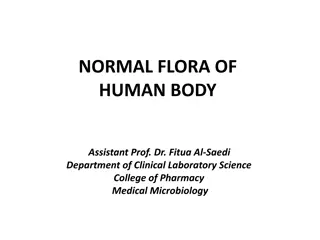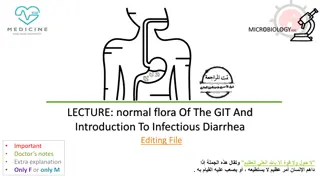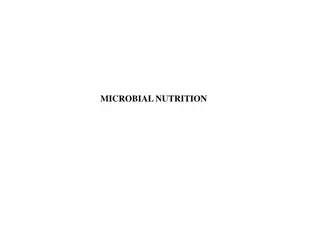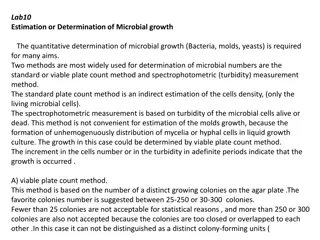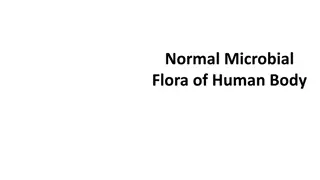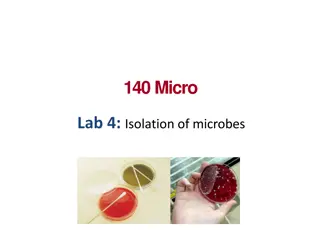Microbial Flora and Symbiotic Relationships
Delve into the world of indigenous flora, colonization, and normal microbial flora residing on the human body. Explore the significance of normal flora in influencing host health, anatomy, and immunity. Uncover the diverse symbiotic relationships between microbes and their hosts, from mutualistic to opportunistic interactions.
Download Presentation

Please find below an Image/Link to download the presentation.
The content on the website is provided AS IS for your information and personal use only. It may not be sold, licensed, or shared on other websites without obtaining consent from the author.If you encounter any issues during the download, it is possible that the publisher has removed the file from their server.
You are allowed to download the files provided on this website for personal or commercial use, subject to the condition that they are used lawfully. All files are the property of their respective owners.
The content on the website is provided AS IS for your information and personal use only. It may not be sold, licensed, or shared on other websites without obtaining consent from the author.
E N D
Presentation Transcript
Definitions Indigenous flora microorganisms native or belonging naturally to a region. Colonization establishment of a site of reproduction of microbes on a person without necessarily resulting in tissue invasion or damage
Normal Microbial Flora Resident Flora (Indigenous flora) Microbes that are always present Transient Flora Microbes that live in or on your body for a period of time (hours, days, weeks, months) then move on or die off
Symbiotic Relationship Neutralism 1. 2. Mutualistic Escherichia coli Protozoa in Termites 2. Commensalistic Demodex 3. Parasitism Trypanosoma gambiense 4. Opportunistic
Commensalistic We have no Commensalistic relationships with Bacteria If Bacteria are in or on our body, they are either helping us (Microbial Antagonism) or harming us.
Opportunistic Especially in hosts rendered susceptible by: 1. Immuno-suppression (AIDS) 2. Radiation therapy & Chemotherapy 3. Perforated mucous membranes 4. Rheumatic heart disease etc. Escherichia coli - normally in our digestive tract where it causes no problems, but if it gets into the urinary tract it can become pathogenic. Staphylococcus aureus commonly found in the upper respiratory tract, but if it gets into a wound or a burn it can become pathogenic
Normal flora 1. A diverse microbial flora Human body Area: the skin and mucous membranes Number: 1014 bacteria 1013 host cells 2. Normal flora may: a. Aid the host b. Harm the host (in sometimes) Viruses and parasites NOT normal microbial flora 3. Most investigators consider that they are not commensals and do not aid the host.
Significance of normal flora The normal flora influences the anatomy, physiology, susceptibility to pathogens, and morbidity of the host. Normal flora may aid the host in several ways: Aid in digestion of food and produce vitamins eg, Vit. K Help the development of mucosal immunity. Protect the host from colonization with pathogenic microbes.
Factors influencing microbial flora 1. Local Environment (pH, temperature, redox potential, O2, H2O, and nutrient levels ). 2. Diet 3. Age 4. Health condition (immune activity ) 5. Antibiotics, ..etc
Distribution of normal flora in the body Skin A. Eye B. Mouth and nose C. Intestinal tract D. Urogenital tract E.






